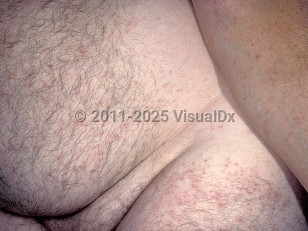Ehrlichiosis
Alerts and Notices
Important News & Links
Synopsis

Human ehrlichiosis and anaplasmosis refer to infections due to bacteria belonging to the family Anaplasmataceae. The species responsible for the majority of human infections are Anaplasma phagocytophilum, which causes human granulocytotropic (or granulocytic) anaplasmosis; Ehrlichia chaffeensis, which causes human monocytic ehrlichiosis (HME); Ehrlichia ewingii; and Ehrlichia muris eauclairensis. Ehrlichia canis is also a very rare cause of human disease. This summary focuses on ehrlichiosis.
Tick vectors and specific mammalian hosts (eg, deer, dogs, mice, and cattle) form the natural zoonotic cycle for the bacteria of human ehrlichiosis. Infection follows bites from infected ticks: the lone-star tick (Amblyomma americanum) and the blacklegged tick (Ixodes scapularis). In the United States, HME and E ewingii infections are most commonly reported in the southeastern, south-central, and mid-Atlantic states. Similar to other tickborne illnesses, the majority of disease occurs in the warmer months of spring and summer and is more frequently noted to occur in men.
Of note, sennetsu fever is a rare infection and no longer considered an ehrlichiosis. It is caused by Neorickettsia sennetsu (formerly Ehrlichia sennetsu); it may be transmitted by trematodes in fish and causes a mono-like illness with fever, lymphadenopathy, myalgia, and headache. Sennetsu fever may pose a risk to inhabitants and travelers to Japan and Malaysia. Cases from Europe have been reported as well.
Ehrlichiosis has a range of presentations from asymptomatic infection to severe acute infection. Fever, headache, chills, malaise, myalgia, anorexia, nausea, vomiting, abdominal pain, arthralgias, nonproductive cough, and confusion may occur after an incubation period of 7-10 days (range 7-21 days) after the tick bite. Although mild or moderate courses are typical, subclinical and fatal cases have been reported, with older and immunocompromised patients having more severe disease. Some untreated patients may have a prolonged febrile illness. An exanthem has been reported in up to 30% of adult patients and up to 60% of pediatric patients (particularly with E chaffeensis), usually developing around 5 days after fever begins, but more commonly a faint, blanchable generalized erythema (toxic erythema) is present. Hepatosplenomegaly occurs in about half of the patients. Periorbital edema, conjunctival injection, and mental status changes may be present on examination. Lymphadenopathy is most often localized. Widespread erythema, multiorgan dysfunction, coma, renal failure, and hypotension may resemble toxic shock syndrome. Neurologic symptoms are seen in about 1 in 5 cases, including altered mental status changes, meningismus, clonus, and signs of meningoencephalitis.
The mortality rate overall is approximately 3% for human monocytic ehrlichiosis; human granulocytic ehrlichiosis is generally milder, but a few fatalities have been reported, particularly in the immunocompromised.
Tick vectors and specific mammalian hosts (eg, deer, dogs, mice, and cattle) form the natural zoonotic cycle for the bacteria of human ehrlichiosis. Infection follows bites from infected ticks: the lone-star tick (Amblyomma americanum) and the blacklegged tick (Ixodes scapularis). In the United States, HME and E ewingii infections are most commonly reported in the southeastern, south-central, and mid-Atlantic states. Similar to other tickborne illnesses, the majority of disease occurs in the warmer months of spring and summer and is more frequently noted to occur in men.
Of note, sennetsu fever is a rare infection and no longer considered an ehrlichiosis. It is caused by Neorickettsia sennetsu (formerly Ehrlichia sennetsu); it may be transmitted by trematodes in fish and causes a mono-like illness with fever, lymphadenopathy, myalgia, and headache. Sennetsu fever may pose a risk to inhabitants and travelers to Japan and Malaysia. Cases from Europe have been reported as well.
Ehrlichiosis has a range of presentations from asymptomatic infection to severe acute infection. Fever, headache, chills, malaise, myalgia, anorexia, nausea, vomiting, abdominal pain, arthralgias, nonproductive cough, and confusion may occur after an incubation period of 7-10 days (range 7-21 days) after the tick bite. Although mild or moderate courses are typical, subclinical and fatal cases have been reported, with older and immunocompromised patients having more severe disease. Some untreated patients may have a prolonged febrile illness. An exanthem has been reported in up to 30% of adult patients and up to 60% of pediatric patients (particularly with E chaffeensis), usually developing around 5 days after fever begins, but more commonly a faint, blanchable generalized erythema (toxic erythema) is present. Hepatosplenomegaly occurs in about half of the patients. Periorbital edema, conjunctival injection, and mental status changes may be present on examination. Lymphadenopathy is most often localized. Widespread erythema, multiorgan dysfunction, coma, renal failure, and hypotension may resemble toxic shock syndrome. Neurologic symptoms are seen in about 1 in 5 cases, including altered mental status changes, meningismus, clonus, and signs of meningoencephalitis.
The mortality rate overall is approximately 3% for human monocytic ehrlichiosis; human granulocytic ehrlichiosis is generally milder, but a few fatalities have been reported, particularly in the immunocompromised.
Codes
ICD10CM:
A77.40 – Ehrlichiosis
A77.49 – Other ehrlichiosis
SNOMEDCT:
240626005 – Human ehrlichiosis
A77.40 – Ehrlichiosis
A77.49 – Other ehrlichiosis
SNOMEDCT:
240626005 – Human ehrlichiosis
Look For
Subscription Required
Diagnostic Pearls
Subscription Required
Differential Diagnosis & Pitfalls

To perform a comparison, select diagnoses from the classic differential
Subscription Required
Best Tests
Subscription Required
Management Pearls
Subscription Required
Therapy
Subscription Required
References
Subscription Required
Last Reviewed:05/31/2022
Last Updated:07/05/2022
Last Updated:07/05/2022
Ehrlichiosis

